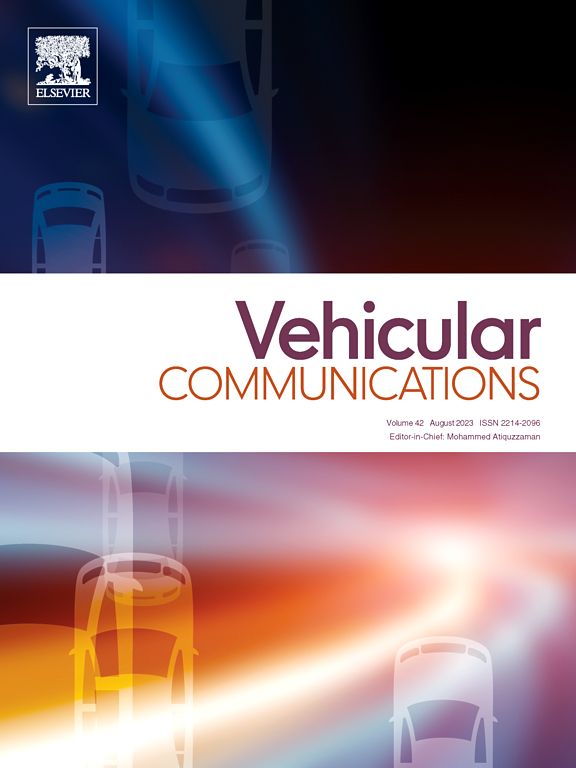车辆网络多通道运行机制评价
IF 6.5
2区 计算机科学
Q1 TELECOMMUNICATIONS
引用次数: 0
摘要
随着协作式智能交通系统(C-ITS)的大规模部署,为联网车辆开发的服务需要一个高效、可靠和可预测的网络接入,以确保正常运行。欧洲电信标准协会(ETSI)第2版业务不能使用单个控制通道进行部署,而需要管理应用程序同时使用的多个通道。因此,ETSI定义了一种称为多通道操作(MCO)的机制。推荐了两种简单的MCO负载分配机制:负载平衡和顺序填充,但直到现在还没有对它们进行详细的评估。本文对这两种机制及其拥塞控制变体进行了评估。已经为这样的工作实现了一个开源模拟框架,它对未来的扩展是开放的。然后,通过ETSI模拟设置后的多次评估,我们讨论了这些机制在使用不同交通负载和车辆密度的高度拥挤介质下的行为。我们的研究结果表明,在高负载条件下,由于通道在切换到新通道之前已经饱和(顺序填充)和车辆之间通道分配的同步(负载平衡),MCO的改进是有限的,并且引入简单的反应性拥塞控制并不能提高它们的性能。研究了主要的局限性,并提出了指导这些机制发展的建议。本文章由计算机程序翻译,如有差异,请以英文原文为准。
Evaluation of multichannel operation mechanisms for vehicular networks
Upon the massive deployment of Cooperative Intelligent Transportation Systems (C-ITS), services developed for connected vehicles need an efficient, reliable and predictable network access to assure proper operation. European Telecommunications Standards Institute (ETSI) Release 2 services cannot be deployed using a single control channel, and require the management of multiple channels used simultaneously by applications. Because of this, ETSI defined a mechanism called Multi-Channel Operation (MCO). Two simple MCO load allocation mechanisms have been recommended, load balancing and sequential filling, but they have not been evaluated in detail until now. In this paper, these two mechanisms, as well as their congestion control variants, are evaluated. An open-source simulation framework has been implemented for such a work, which is open to future extensions. Then, through multiple evaluations following the ETSI simulation setup, we discuss the behavior of these mechanisms under scenarios with a highly congested medium, employing different traffic loads and vehicular densities. Our results show that MCO improvement is limited under high-load conditions, by saturation of channels before switching to a new one (sequential filling) and synchronization of channel assignment among vehicles (load balancing), and the introduction of a simple reactive congestion control does not improve their performance. The main limitations are examined, and recommendations are provided to guide the evolution of these mechanisms.
求助全文
通过发布文献求助,成功后即可免费获取论文全文。
去求助
来源期刊

Vehicular Communications
Engineering-Electrical and Electronic Engineering
CiteScore
12.70
自引率
10.40%
发文量
88
审稿时长
62 days
期刊介绍:
Vehicular communications is a growing area of communications between vehicles and including roadside communication infrastructure. Advances in wireless communications are making possible sharing of information through real time communications between vehicles and infrastructure. This has led to applications to increase safety of vehicles and communication between passengers and the Internet. Standardization efforts on vehicular communication are also underway to make vehicular transportation safer, greener and easier.
The aim of the journal is to publish high quality peer–reviewed papers in the area of vehicular communications. The scope encompasses all types of communications involving vehicles, including vehicle–to–vehicle and vehicle–to–infrastructure. The scope includes (but not limited to) the following topics related to vehicular communications:
Vehicle to vehicle and vehicle to infrastructure communications
Channel modelling, modulating and coding
Congestion Control and scalability issues
Protocol design, testing and verification
Routing in vehicular networks
Security issues and countermeasures
Deployment and field testing
Reducing energy consumption and enhancing safety of vehicles
Wireless in–car networks
Data collection and dissemination methods
Mobility and handover issues
Safety and driver assistance applications
UAV
Underwater communications
Autonomous cooperative driving
Social networks
Internet of vehicles
Standardization of protocols.
 求助内容:
求助内容: 应助结果提醒方式:
应助结果提醒方式:


